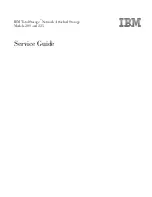
36
drives.
Fault
Tolerant
(RAID 1)
2 hard disk drives are required to create a RAID1 array. RAID1 can
provide disk mirroring by duplicating the data between two hard
disk drives.
Fault
Tolerant
(RAID 5)
A minimum of 3 hard disk drives are required to create RAID5. The
data are striped in all hard drives in a RAID5 array and the parity
information is stored in each drive. If a hard disk drive fails, the
array enters degraded mode. The data can be rebuilt from other
member drives after installing a new drive to replace the failed
one.
Fault
Tolerant
(RAID 6)
To have the best performance, a minimum of 6 hard disk drives
are required to create RAID6. The data are striped in all hard
drives in a RAID6 array and the parity information is stored in each
drive. It tolerates failure of two hard drives. The data can be
rebuilt from other member drives after installing a new drive to
replace the failed one.
Fault
Tolerant
(Raid10)
Data are written in stripes across primary disks that have been
mirrored to the secondary disks. A typical RAID 10 configuration
consists of four drives, two for striping and two for mirroring
Please wait. The disk configuration is in a process.
Users can check RAID rebuilding status from Device List (rebuilding: orange, ready: green).
iSCSI Server will show its approximate rebuilding time and percentage if it is created to
RAID 1/5/6/10 (with fault tolerance ability).
Note:
Users can quickly check device status from Device List.
Green
=active,
Orange
=rebuilding,
Red
= failed or error,
Gray
=used as LUN
Содержание IDS-T16000-RM
Страница 9: ...8 29 Power switch ...
Страница 16: ...15 ...
Страница 46: ...45 ...
Страница 66: ...65 the function effective ...
















































